
Saturday May 22, 2021
By Aurora Almendral
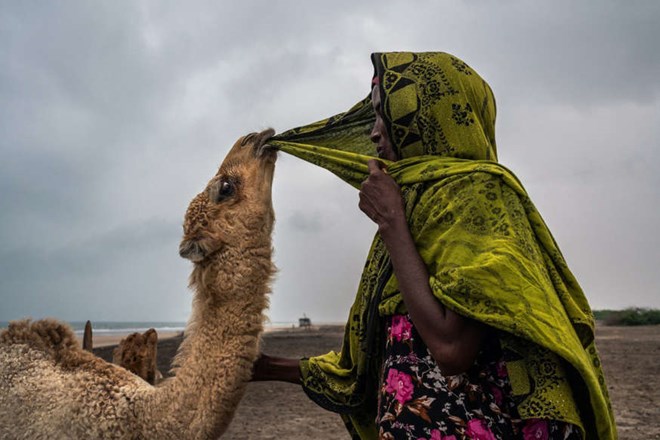
© Photograph by Nichole Sobecki, National Geographic Five-month-old camel Baarud playfully pulls at Aadar Mohamed's (44) hijab in Hiijinle village outside Lughaya in north-western Somaliland, on December 10, 2019. Baarud, which means tough in Somali, was given this name because when his mother was pregnant with him she nearly died in the drought. Seeing how close to death she was Aadar managed to secure some porridge to nurse her back to life. With the IOM predicting 200 million environmentally displaced people by 2050, countless Somalis will be pushed from their homes, with women and girls bearing the weight of displacement. Exacerbated by other factors, such as increased poverty, overcrowded and unsafe living conditions in temporary housing, loss of community, and increased power imbalances, Nichole documents how climate change has contributed to the increase of violence against women and girls.
Some camels on the beach lay splayed on their sides like sleeping cats. Others hoisted themselves up on their long legs, blinking at the brightening dawn sky. Others loped across the sand as curly-haired calves frolicked in playful loops or teetered on spindly legs, bellowing for milk.
Xijiinle is a coastal settlement of about 200 seminomadic pastoralists in Somaliland, an autonomous region of northern Somalia. The village lies at the end of a dirt road that runs 200 miles from Hargeysa, Somaliland’s capital, through a rugged landscape of dry brush, dusty gullies, and open meadows, greened from recent rain. Hamlets like this, with their domed huts made of gathered branches and draped cloths, are centers of an age-old camel herding tradition.
“We understand each other, us and the camels,” Rashiid Jaamac told me that December morning in 2019 on the beach at Xijiinle. Jaamac, who estimated that he was about 50 years old, owned 52 of the several hundred camels there. He was milking one of them, catching the precious liquid in a conical bowl tucked into the crook of his knee as he tugged at the animal’s udders.
People in this unforgiving land also tend goats, sheep, and cattle, but, Jaamac said, “Somalis love camels the most.” Camel milk has always been a staple food, and the villagers will kill one of their animals for meat only when it’s dying of natural causes.
The lives of humans and camels have long been bound together by mutual need and affection. Jaamac said that when his camels come back from grazing, they recognize him and greet him as if they were his pets.
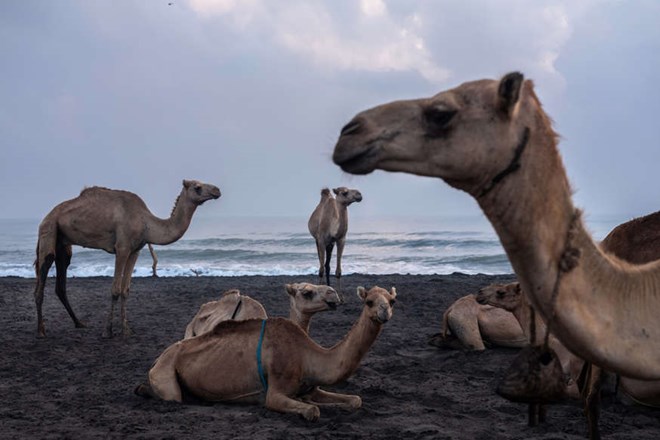
© Photograph by Nichole Sobecki, National Geographic Around 200 camels wake at dawn on the shores of the Gulf of Aden in Hiijinle village outside Lughaya in north-western Somaliland, on December 11, 2019. Before the droughts, herder Rashid Jaama told us, there would have been so many camels they would have blocked out the view of the sea. Camels are the heart of Somali culture, and the lives of these lanky, humped animals are intimately tied to the pastoral communities that herd them. Now, climate change and increasingly frequent drought are making pastoralism increasingly untenable — and leading to the end of a way of life. With the IOM predicting 200 million environmentally displaced people by 2050, countless Somalis will be pushed from their homes, with women and girls bearing the weight of displacement. Exacerbated by other factors, such as increased poverty, overcrowded and unsafe living conditions in temporary housing, loss of community, and increased power imbalances, Nichole documents how climate change has contributed to the increase of violence against women and girls.
As he put it, “There's no culture for Somalis if they don't have camels.”
But today, that ancient Somali human-camel relationship is in jeopardy.
In the Horn of Africa, people expect periodic droughts—but during the past three decades, dry years have been unusually frequent, leaving pastoralists no time to recover between disasters. Starting in 2015, successive drought years devastated livestock herds. Trees and grasses withered and died; villagers spent days leading their parched animals to rumored watering holes, only to find them dry. As the herd owners watched helplessly, their animals died by the hundreds in just weeks, leaving the landscape littered with skeletons.
The droughts drove hundreds of thousands of Somalis into makeshift camps or to burgeoning towns and cities such as Hargeysa. Many left for jobs in Gulf states and elsewhere, joining family members in the global Somali diaspora. An unknown number became swept up in human trafficking networks with the hope of crossing into Europe. (Meet some of the millions of women who migrated recently, risking everything.)
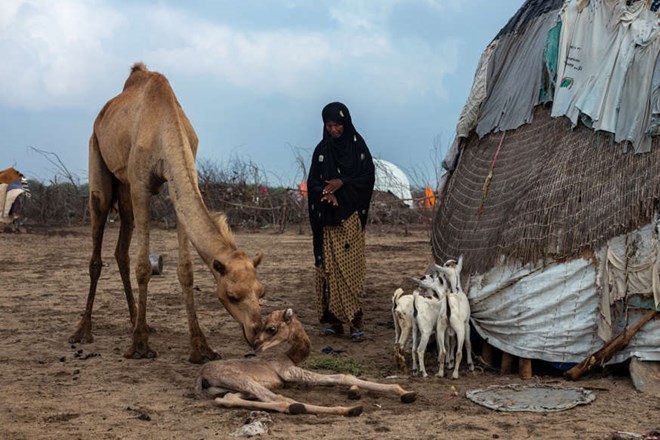
© None A mother camel touches noses with its 10-day-old infant beside Nimao Jaama (40) and the family's goats in Hiijinle village outside Lughaya in north-western Somaliland, on December 11, 2019. It takes a camel nearly two weeks to take its first steps. With the IOM predicting 200 million environmentally displaced people by 2050, countless Somalis will be pushed from their homes, with women and girls bearing the weight of displacement. Exacerbated by other factors, such as increased poverty, overcrowded and unsafe living conditions in temporary housing, loss of community, and increased power imbalances, Nichole documents how climate change has contributed to the increase of violence against women and girls.
Odes to camels
In the red light of morning there is glory in your eyes,
O you who ennoble with your presence
Raage Ugaas wrote this stanza in his 19th-century poem about the virtues of camels. He goes on to praise their pleasing bellows and “bubbling growl”; their dependability, even during droughts, to produce bowls of warm, frothy milk; and how camels save nomads from despair when the humans load their possessions onto their animals’ backs to trek to greener pastures.
Yahye Yeebaash, a young spoken-word poet in Hargeysa, translated this verse from an anonymous ode written about a century ago:
If I die, my dear camel, there will be no children and family,
But if you die, there will be empty plates and people will starve to death
Yeebaash gleaned this from another anonymous poem:
Weakness is when you have goats
Lavishness is when you have a horse
Human power is when you have a boy
Richness is when you have a camel
When I asked Jaamac how he tells his camels apart, he said, “Something that’s your own has people’s eyes.”

© Photograph by Nichole Sobecki, National Geographic Camels graze at dawn along the hills outside Xooga Caddada village, Somaliland, between Quljeed and Bown towns, just along the border with Ethiopia, on August 15, 2020. Many of the cheetah who are eventually trafficked by smugglers are first removed from the wild by nomadic pastoralists in Somaliland and Ethiopia, in a widespread form of human-wildlife conflict where the cheetah prey on the livestock these communities rely on, leading to retaliation and the capturing of cheetah cubs to compensate for their lost livestock. Resource-poor Somaliland is a hub for the cheetah trade, and experts estimate that hundreds of cubs are shipped by boat across the Gulf of Aden to Yemen, then driven overland to Gulf states, each year. But as awareness of this secretive trade grows, Somaliland is making efforts to end cheetah trafficking, handing down stiff jail sentences to traffickers, trying to grow awareness of the value of wildlife, and ramping up confiscations—not just of cheetahs but also of animals such as dik-diks and leopards. With just 7,100 cheetahs left in the wild, the world’s fastest land mammal is racing toward extinction, with the latest cheetah census suggesting that the big cats may decline by an additional 53 percent over the next 15 years.
Somalis know what makes their camels happy. Megaag and qudhac are their favorite trees to graze on, he said. When they eat kulan, a date-like fruit, their milk is sweeter. And they know what makes camels sad. Males bellow when they can’t find a mate; females weep when they lose a calf, Jaamac said. All camels panic if separated from their herd, gurgling and pacing frantically.
“We sing for them just like we sing for children when they're crying and when we want them to eat,” said Zahra Axmed, also from Xijiinle. To coax their camels to drink from a watering hole, she said, they sing a soft, rhythmic lullaby:
Where is the hump that formed over the dry season?
Where is the magnificent, sleek, dazzling, O camel, by which ladies became bewitched?
Where is the pearl, when you are wholesome, that hung from your breast and udder?
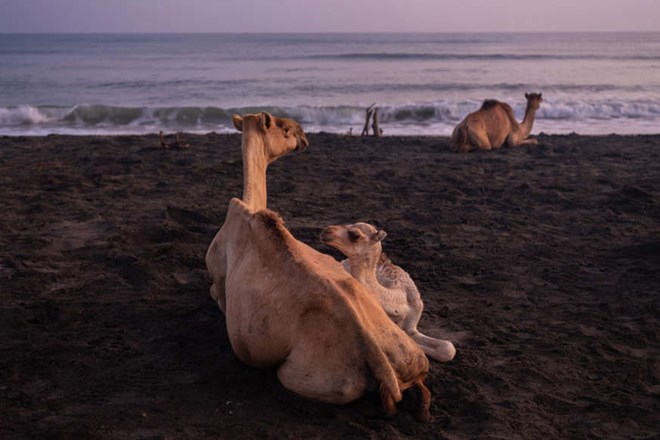
© Photograph by Nichole Sobecki, National Geographic Around 200 camels wake at dawn on the shores of the Gulf of Aden in Hiijinle village outside Lughaya in north-western Somaliland, on December 12, 2019. Before the droughts, herder Rashid Jaama told us, there would have been so many camels they would have blocked out the view of the sea. Camels are the heart of Somali culture, and the lives of these lanky, humped animals are intimately tied to the pastoral communities that herd them. Now, climate change and increasingly frequent drought are making pastoralism increasingly untenable — and leading to the end of a way of life. With the IOM predicting 200 million environmentally displaced people by 2050, countless Somalis will be pushed from their homes, with women and girls bearing the weight of displacement. Exacerbated by other factors, such as increased poverty, overcrowded and unsafe living conditions in temporary housing, loss of community, and increased power imbalances, Nichole documents how climate change has contributed to the increase of violence against women and girls.
Jaamac knows all his camels by name—the naughty ones that need a wooden bell strung around their necks, the males that nurse jealousies and must have their ankles hobbled to keep them from fighting. Somalis are so close to their camels, so driven to keep their herds’ numbers up, Jaamac said, that when a pair of cames on the beach started to mate, one of herders crouched beside them and used his hand to guide the male into the female.
Jaamac stopped accompanying the family’s camels to the pastures when he turned 50—he was too old to fight off the hyenas that prey on the animals, he said. “When the camel sees a hyena, they just start peeing,” his wife, Cadar Maxamed, added, laughing. Herders use various methods against hyenas, from raiding their dens and killing cubs to shining flashlights in their eyes, even shooting them with AK47s, Jaamac said.
“Looking at the camel is like looking at our whole life,” Maxamed declared. “If the camel is fine, our life is fine.”
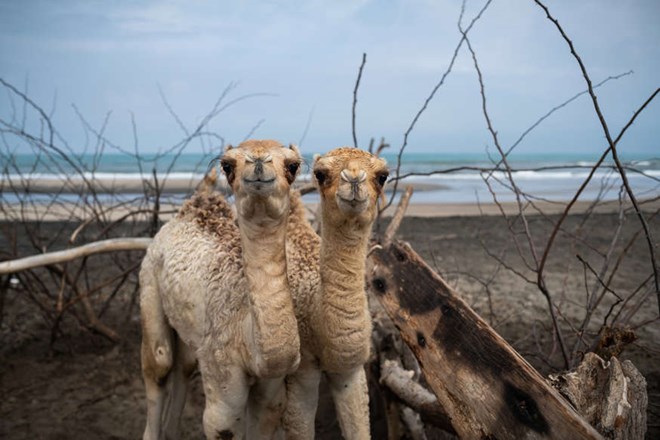
© Photograph by Nichole Sobecki, National Geographic Five-month-old camels Mudha and Baarud in their enclosure on the shores of the Gulf of Aden in Hiijinle village outside Lughaya in north-western Somaliland, on December 10, 2019. Baarud, which means tough in Somali, was given this name because when his mother was pregnant with him she nearly died in the drought. Seeing how close to death she was the family managed to secure some porridge to nurse her back to life. With the IOM predicting 200 million environmentally displaced people by 2050, countless Somalis will be pushed from their homes, with women and girls bearing the weight of displacement. Exacerbated by other factors, such as increased poverty, overcrowded and unsafe living conditions in temporary housing, loss of community, and increased power imbalances, Nichole documents how climate change has contributed to the increase of violence against women and girls.
‘I cry with her’
As the recent droughts show, climate change is pushing this part of the Horn of Africa into extremes that challenge the ability of the land to sustain camels and other livestock.
In Xijiinle, the camels’ humps shrank, and their milk dried up. The calves looked skeletal. Animals that hyenas typically hunt—wild cats, baboons, and dik-dik, a tiny antelope—starved, so the famished predators killed more camels. When humanitarian aid organizations came to the village to distribute corn for porridge, people shared it with their camels. It wasn’t always enough. When a camel becomes too weak to eat or drink, it sits on the sand and over several days fades away.
There is no song for a camel on the brink of death. “When she cries,” Jaamac said, “I cry with her.”
The erratic weather conditions that produced the deadly droughts also brought a cyclone in 2018, a calamity no one in Xijiinle had experienced before. As the storm bore down, people huddled together in an open field, clutching each other to keep from being swept away.
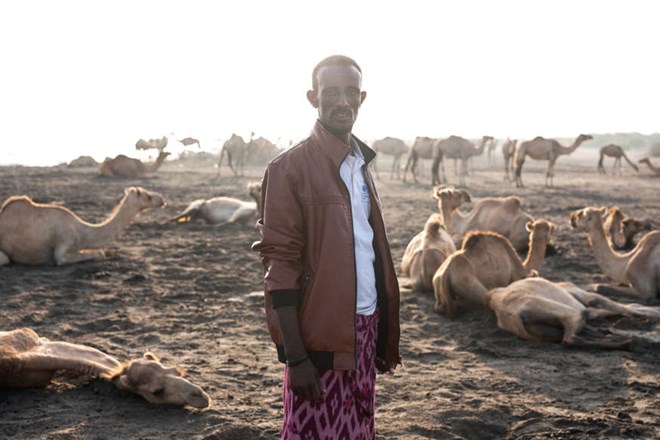
© Photograph by Nichole Sobecki, National Geographic Portrait of herdsman Mahmoud Ali Hussein (36) in Hiijinle village outside Lughaya in north-western Somaliland, on December 12, 2019. Mahmoud says depending on the life of animals who may die in increasingly frequent droughts has become too hard. While he can't bear to leave the herds his father left tor him to die alone, he's preparing his son for another life outside of pastoralism. Camels are the heart of Somali culture, and the lives of these lanky, humped animals are intimately tied to the pastoral communities that herd them. Now, climate change and increasingly frequent drought are making pastoralism increasingly untenable — and leading to the end of a way of life. With the IOM predicting 200 million environmentally displaced people by 2050, countless Somalis will be pushed from their homes, with women and girls bearing the weight of displacement. Exacerbated by other factors, such as increased poverty, overcrowded and unsafe living conditions in temporary housing, loss of community, and increased power imbalances, Nichole documents how climate change has contributed to the increase of violence against women and girls.
When it passed, huts were gone. Hundreds of camels had been swept out to sea or buried in the sand, where they suffocated. Between the cyclone and the droughts, Jaamac and Maxamed lost 15 camels. Others in Xijiinle fared worse, Jaamac said, losing nearly all their animals. (In the face of extreme droughts, Somali women face a dangerous new world.)
Mudha and Baruud
Before the droughts, Jaamac said as we spoke on Xijiinle’s beach, there would have been so many camels here that “you wouldn’t have been able to see the sea.”
In a circular enclosure made of branches staked into the sand, was a pair of pale calves so young that their umbilical cords still dangled from their bellies. When Maxamed went up to them, they greeted her by bumping their heads against her hands and tugging at her hijab. She stroked their tufts of fur and cooed at them. Their names are Mudha, a type of tree that Maxamed described as “bright and beautiful,” and Baruud, which means tough.
Baruud’s mother was pregnant during the drought and was pacing around the way camels do before their death spiral begins. Maxamed walked two hours from the village to the hospital to get food for the camel and nursed her back from the brink.
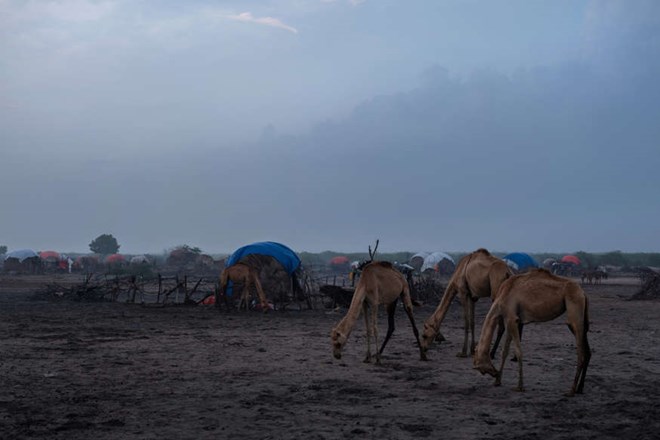
© Photograph by Nichole Sobecki, National Geographic Around 200 camels wake at dawn on the shores of the Gulf of Aden in Hiijinle village outside Lughaya in north-western Somaliland, on December 11, 2019. Before the droughts, herder Rashid Jaama told us, there would have been so many camels they would have blocked out the view of the sea. Camels are the heart of Somali culture, and the lives of these lanky, humped animals are intimately tied to the pastoral communities that herd them. Now, climate change and increasingly frequent drought are making pastoralism increasingly untenable — and leading to the end of a way of life. With the IOM predicting 200 million environmentally displaced people by 2050, countless Somalis will be pushed from their homes, with women and girls bearing the weight of displacement. Exacerbated by other factors, such as increased poverty, overcrowded and unsafe living conditions in temporary housing, loss of community, and increased power imbalances, Nichole documents how climate change has contributed to the increase of violence against women and girls.
After Baruud was born, the mother started making milk again, enough for Jaamac and Maxamed’s family to have some too.
Fear that they might lose their herds in increasingly frequent, punishing droughts hangs over Xijiinle’s pastoralists, and according to the United Nations, 2021 may prove to be another drought year. Jaamac said that even if all the family’s camels die in droughts, he’ll go to the city and work as long as it takes to buy two female camels and one male. Then he’ll return to Xijiinle to rebuild the herd.
Maxamuud Cali Xuseen sees the future differently. A 36-year-old herder with 35 camels, Xuseen said the cyclone made him realize that the old way of life is now too precarious. He wants something different for his own children, so he sent his eldest son to the nearest town, Lughaya, to study, in the hope that one day he’ll be equipped to get a good job abroad.
Asma Dhamac contributed reporting in Somaliland.
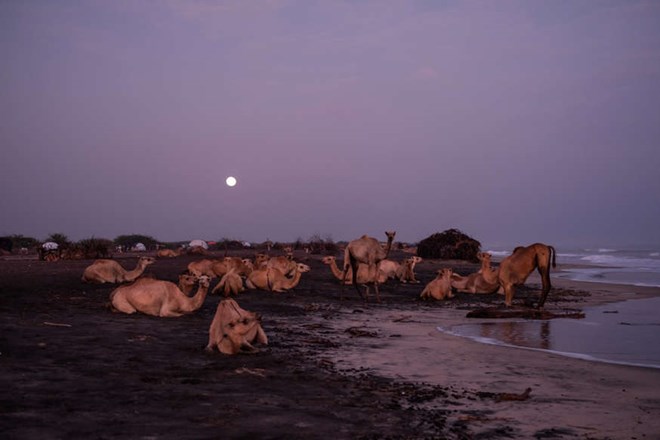
© Photograph by Nichole Sobecki, National Geographic A full moon sets over around 200 waking camels on the shores of the Gulf of Aden in Hiijinle village outside Lughaya in north-western Somaliland, on December 12, 2019. Before the droughts, herder Rashid Jaama told us, there would have been so many camels they would have blocked out the view of the sea. Camels are the heart of Somali culture, and the lives of these lanky, humped animals are intimately tied to the pastoral communities that herd them. Now, climate change and increasingly frequent drought are making pastoralism increasingly untenable — and leading to the end of a way of life. With the IOM predicting 200 million environmentally displaced people by 2050, countless Somalis will be pushed from their homes, with women and girls bearing the weight of displacement. Exacerbated by other factors, such as increased poverty, overcrowded and unsafe living conditions in temporary housing, loss of community, and increased power imbalances, Nichole documents how climate change has contributed to the increase of violence against women and girls.